Financial Accounting Assignment Report BAO2202 Semester 2 2017
VerifiedAdded on 2020/03/01
|17
|4922
|183
Report
AI Summary
This report, prepared for a Financial Accounting course (BAO2202), delves into key aspects of financial reporting. Part I focuses on the qualitative characteristics of financial information as defined by the AASB Framework, emphasizing relevance, faithful representation, comparability, and consistency. The report highlights how these characteristics enhance the decision-usefulness of financial statements for stakeholders. Part II examines AASB 13, which addresses fair value measurement, and discusses its limitations, such as limited reliability, misleading information, and volatility. The report emphasizes the importance of viable disclosure and accounting judgments when applying this standard. The report uses various research articles and journals to support its findings, providing a comprehensive overview of these critical accounting concepts.
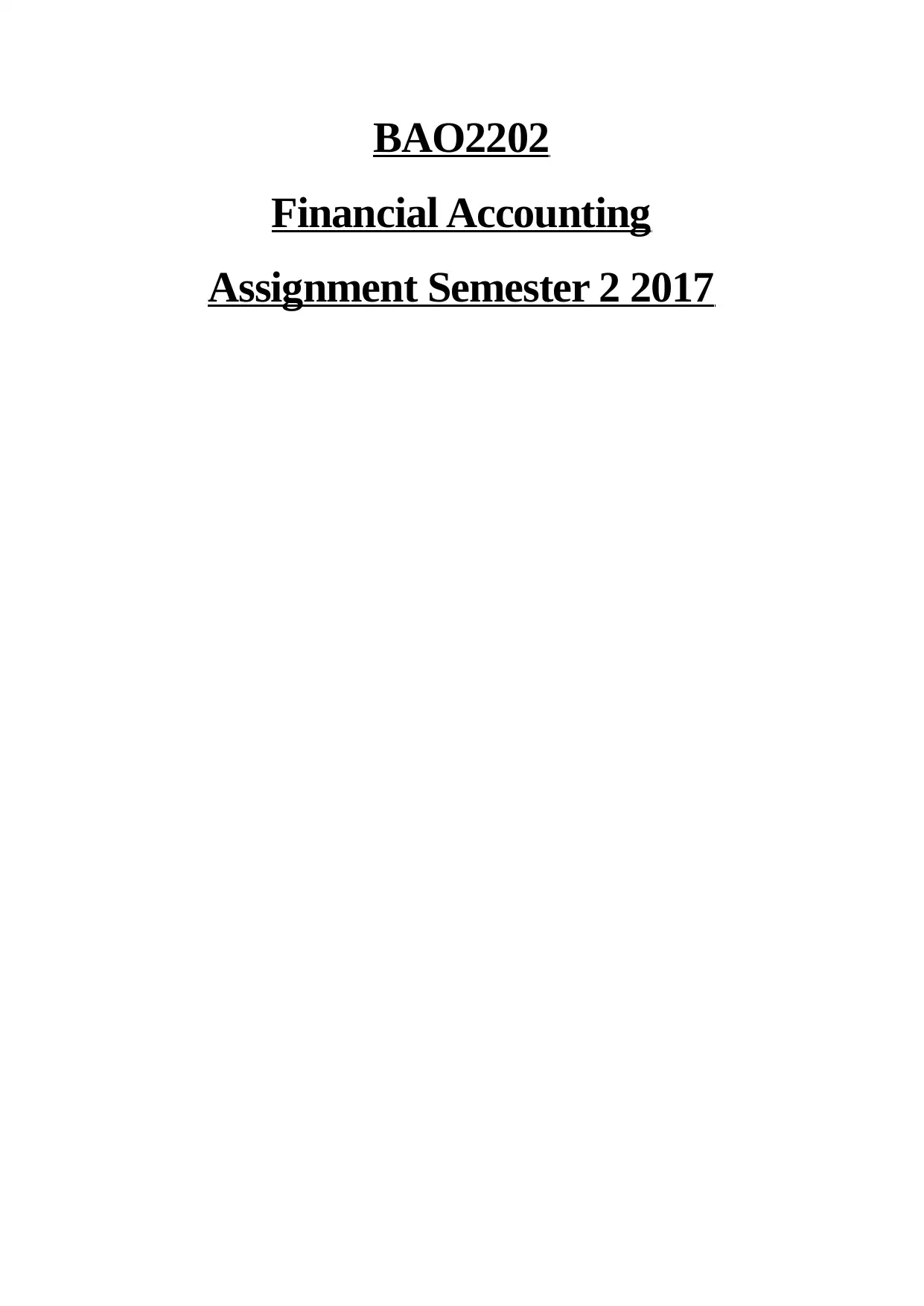
BAO2202
Financial Accounting
Assignment Semester 2 2017
Financial Accounting
Assignment Semester 2 2017
Paraphrase This Document
Need a fresh take? Get an instant paraphrase of this document with our AI Paraphraser
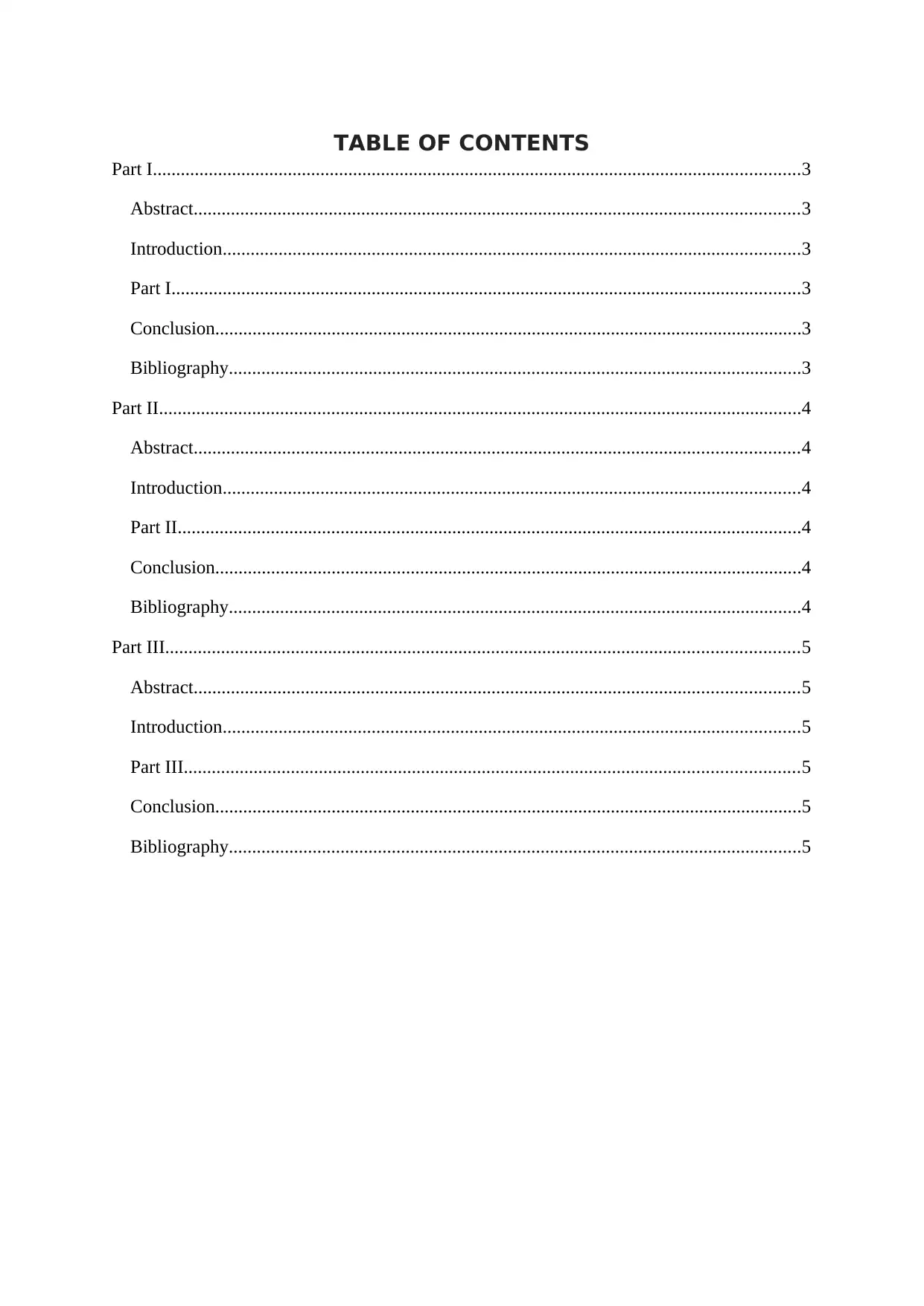
TABLE OF CONTENTS
Part I...........................................................................................................................................3
Abstract..................................................................................................................................3
Introduction............................................................................................................................3
Part I.......................................................................................................................................3
Conclusion..............................................................................................................................3
Bibliography...........................................................................................................................3
Part II..........................................................................................................................................4
Abstract..................................................................................................................................4
Introduction............................................................................................................................4
Part II......................................................................................................................................4
Conclusion..............................................................................................................................4
Bibliography...........................................................................................................................4
Part III........................................................................................................................................5
Abstract..................................................................................................................................5
Introduction............................................................................................................................5
Part III....................................................................................................................................5
Conclusion..............................................................................................................................5
Bibliography...........................................................................................................................5
Part I...........................................................................................................................................3
Abstract..................................................................................................................................3
Introduction............................................................................................................................3
Part I.......................................................................................................................................3
Conclusion..............................................................................................................................3
Bibliography...........................................................................................................................3
Part II..........................................................................................................................................4
Abstract..................................................................................................................................4
Introduction............................................................................................................................4
Part II......................................................................................................................................4
Conclusion..............................................................................................................................4
Bibliography...........................................................................................................................4
Part III........................................................................................................................................5
Abstract..................................................................................................................................5
Introduction............................................................................................................................5
Part III....................................................................................................................................5
Conclusion..............................................................................................................................5
Bibliography...........................................................................................................................5
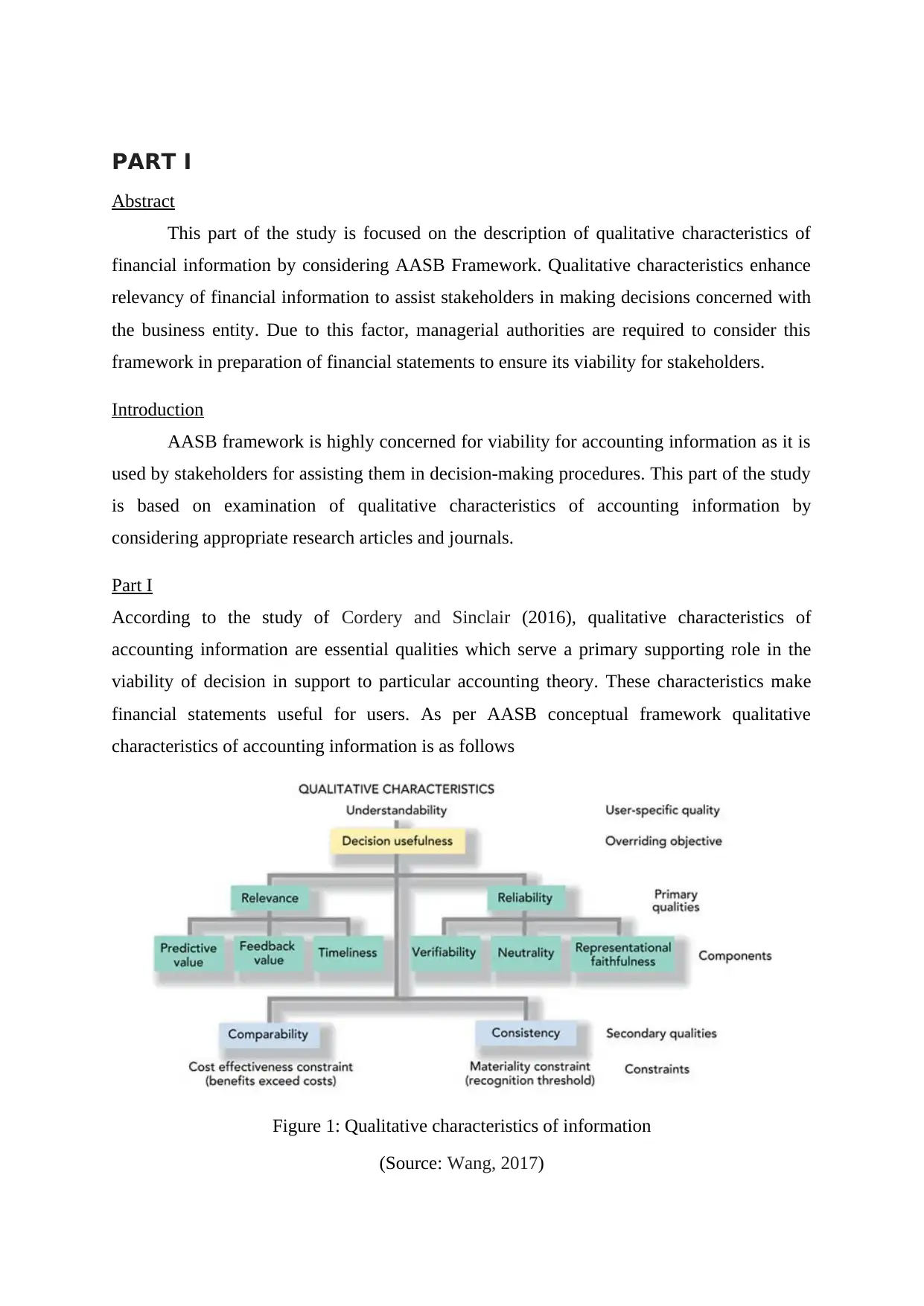
PART I
Abstract
This part of the study is focused on the description of qualitative characteristics of
financial information by considering AASB Framework. Qualitative characteristics enhance
relevancy of financial information to assist stakeholders in making decisions concerned with
the business entity. Due to this factor, managerial authorities are required to consider this
framework in preparation of financial statements to ensure its viability for stakeholders.
Introduction
AASB framework is highly concerned for viability for accounting information as it is
used by stakeholders for assisting them in decision-making procedures. This part of the study
is based on examination of qualitative characteristics of accounting information by
considering appropriate research articles and journals.
Part I
According to the study of Cordery and Sinclair (2016), qualitative characteristics of
accounting information are essential qualities which serve a primary supporting role in the
viability of decision in support to particular accounting theory. These characteristics make
financial statements useful for users. As per AASB conceptual framework qualitative
characteristics of accounting information is as follows
Figure 1: Qualitative characteristics of information
(Source: Wang, 2017)
Abstract
This part of the study is focused on the description of qualitative characteristics of
financial information by considering AASB Framework. Qualitative characteristics enhance
relevancy of financial information to assist stakeholders in making decisions concerned with
the business entity. Due to this factor, managerial authorities are required to consider this
framework in preparation of financial statements to ensure its viability for stakeholders.
Introduction
AASB framework is highly concerned for viability for accounting information as it is
used by stakeholders for assisting them in decision-making procedures. This part of the study
is based on examination of qualitative characteristics of accounting information by
considering appropriate research articles and journals.
Part I
According to the study of Cordery and Sinclair (2016), qualitative characteristics of
accounting information are essential qualities which serve a primary supporting role in the
viability of decision in support to particular accounting theory. These characteristics make
financial statements useful for users. As per AASB conceptual framework qualitative
characteristics of accounting information is as follows
Figure 1: Qualitative characteristics of information
(Source: Wang, 2017)
⊘ This is a preview!⊘
Do you want full access?
Subscribe today to unlock all pages.

Trusted by 1+ million students worldwide
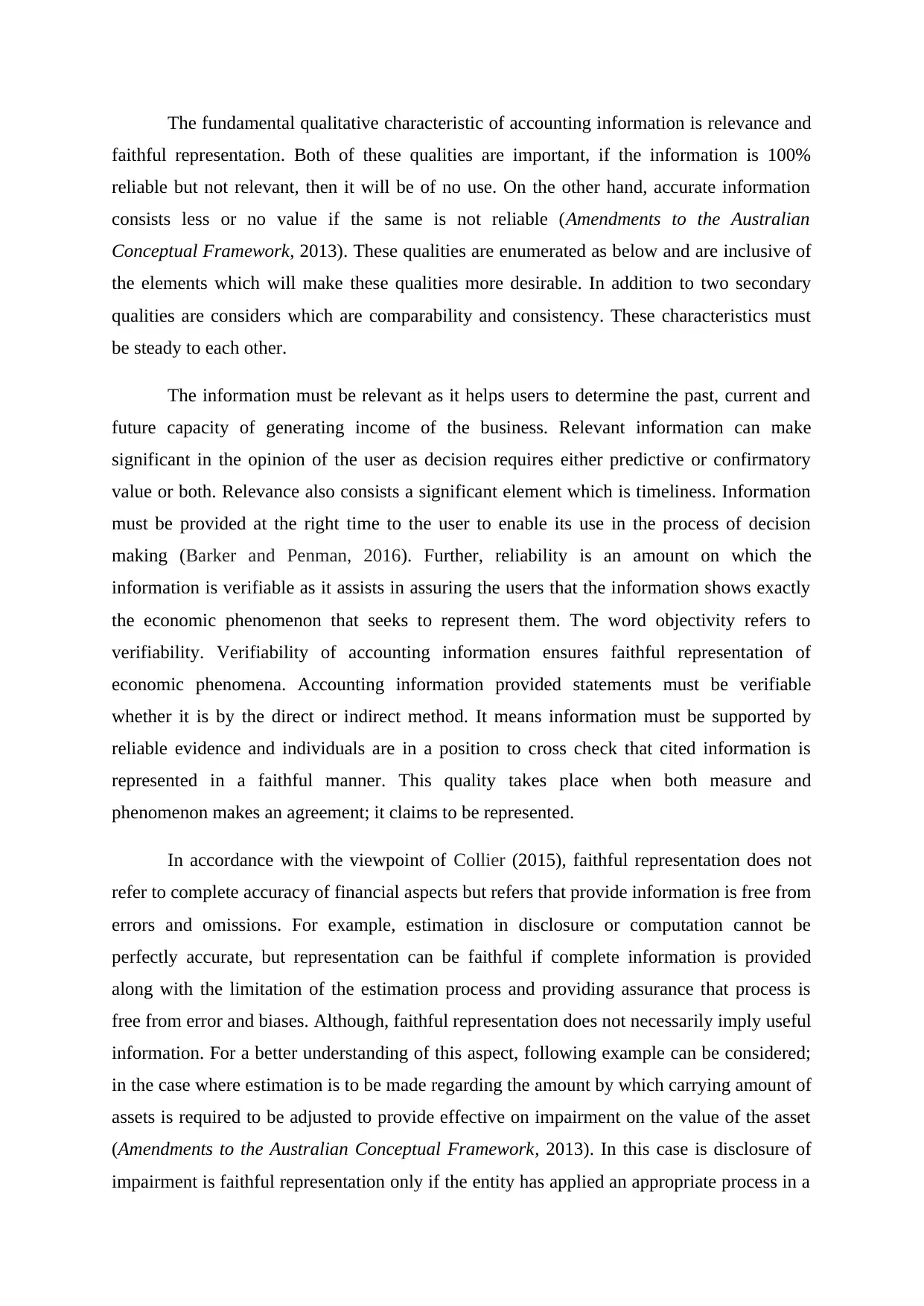
The fundamental qualitative characteristic of accounting information is relevance and
faithful representation. Both of these qualities are important, if the information is 100%
reliable but not relevant, then it will be of no use. On the other hand, accurate information
consists less or no value if the same is not reliable (Amendments to the Australian
Conceptual Framework, 2013). These qualities are enumerated as below and are inclusive of
the elements which will make these qualities more desirable. In addition to two secondary
qualities are considers which are comparability and consistency. These characteristics must
be steady to each other.
The information must be relevant as it helps users to determine the past, current and
future capacity of generating income of the business. Relevant information can make
significant in the opinion of the user as decision requires either predictive or confirmatory
value or both. Relevance also consists a significant element which is timeliness. Information
must be provided at the right time to the user to enable its use in the process of decision
making (Barker and Penman, 2016). Further, reliability is an amount on which the
information is verifiable as it assists in assuring the users that the information shows exactly
the economic phenomenon that seeks to represent them. The word objectivity refers to
verifiability. Verifiability of accounting information ensures faithful representation of
economic phenomena. Accounting information provided statements must be verifiable
whether it is by the direct or indirect method. It means information must be supported by
reliable evidence and individuals are in a position to cross check that cited information is
represented in a faithful manner. This quality takes place when both measure and
phenomenon makes an agreement; it claims to be represented.
In accordance with the viewpoint of Collier (2015), faithful representation does not
refer to complete accuracy of financial aspects but refers that provide information is free from
errors and omissions. For example, estimation in disclosure or computation cannot be
perfectly accurate, but representation can be faithful if complete information is provided
along with the limitation of the estimation process and providing assurance that process is
free from error and biases. Although, faithful representation does not necessarily imply useful
information. For a better understanding of this aspect, following example can be considered;
in the case where estimation is to be made regarding the amount by which carrying amount of
assets is required to be adjusted to provide effective on impairment on the value of the asset
(Amendments to the Australian Conceptual Framework, 2013). In this case is disclosure of
impairment is faithful representation only if the entity has applied an appropriate process in a
faithful representation. Both of these qualities are important, if the information is 100%
reliable but not relevant, then it will be of no use. On the other hand, accurate information
consists less or no value if the same is not reliable (Amendments to the Australian
Conceptual Framework, 2013). These qualities are enumerated as below and are inclusive of
the elements which will make these qualities more desirable. In addition to two secondary
qualities are considers which are comparability and consistency. These characteristics must
be steady to each other.
The information must be relevant as it helps users to determine the past, current and
future capacity of generating income of the business. Relevant information can make
significant in the opinion of the user as decision requires either predictive or confirmatory
value or both. Relevance also consists a significant element which is timeliness. Information
must be provided at the right time to the user to enable its use in the process of decision
making (Barker and Penman, 2016). Further, reliability is an amount on which the
information is verifiable as it assists in assuring the users that the information shows exactly
the economic phenomenon that seeks to represent them. The word objectivity refers to
verifiability. Verifiability of accounting information ensures faithful representation of
economic phenomena. Accounting information provided statements must be verifiable
whether it is by the direct or indirect method. It means information must be supported by
reliable evidence and individuals are in a position to cross check that cited information is
represented in a faithful manner. This quality takes place when both measure and
phenomenon makes an agreement; it claims to be represented.
In accordance with the viewpoint of Collier (2015), faithful representation does not
refer to complete accuracy of financial aspects but refers that provide information is free from
errors and omissions. For example, estimation in disclosure or computation cannot be
perfectly accurate, but representation can be faithful if complete information is provided
along with the limitation of the estimation process and providing assurance that process is
free from error and biases. Although, faithful representation does not necessarily imply useful
information. For a better understanding of this aspect, following example can be considered;
in the case where estimation is to be made regarding the amount by which carrying amount of
assets is required to be adjusted to provide effective on impairment on the value of the asset
(Amendments to the Australian Conceptual Framework, 2013). In this case is disclosure of
impairment is faithful representation only if the entity has applied an appropriate process in a
Paraphrase This Document
Need a fresh take? Get an instant paraphrase of this document with our AI Paraphraser
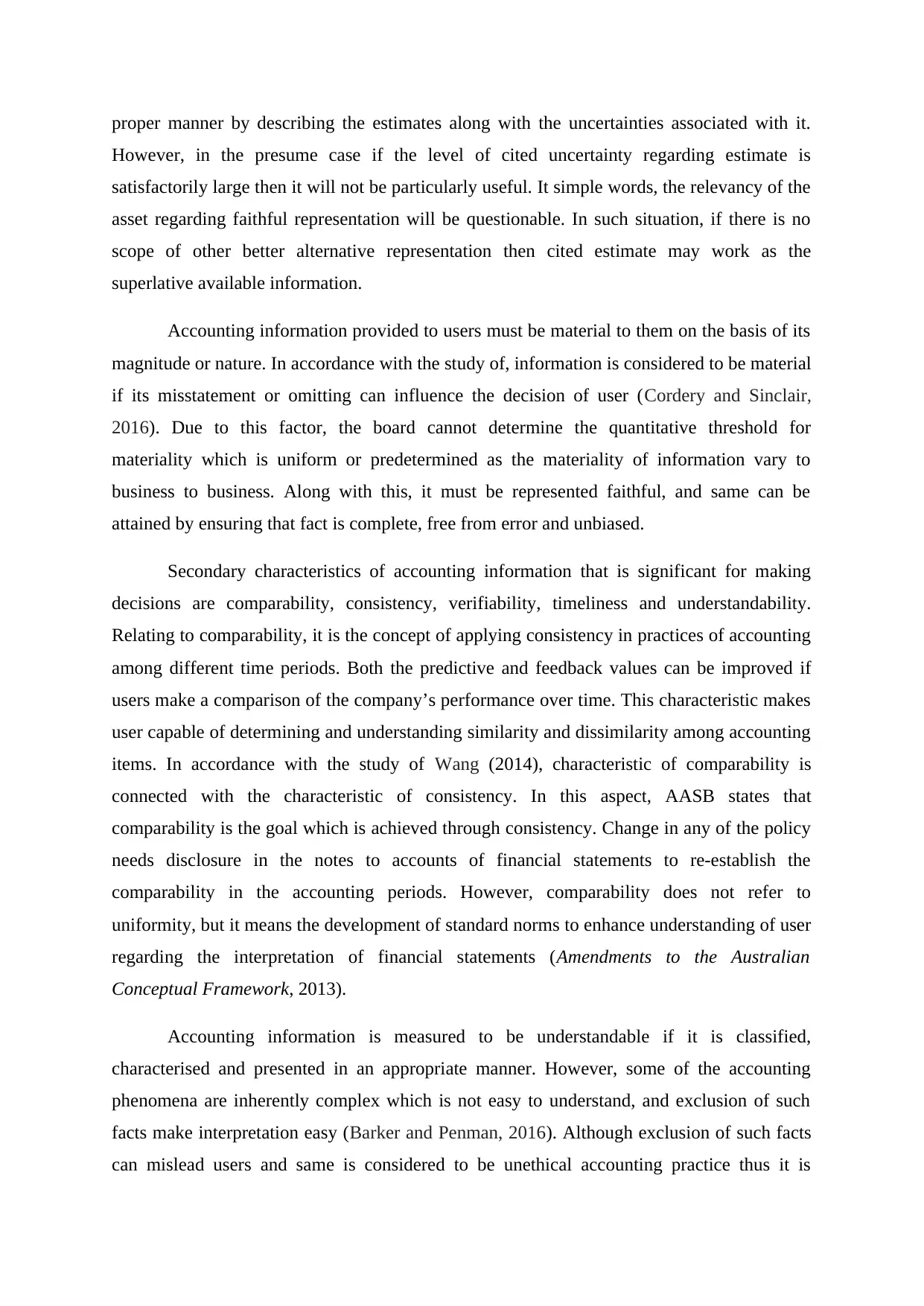
proper manner by describing the estimates along with the uncertainties associated with it.
However, in the presume case if the level of cited uncertainty regarding estimate is
satisfactorily large then it will not be particularly useful. It simple words, the relevancy of the
asset regarding faithful representation will be questionable. In such situation, if there is no
scope of other better alternative representation then cited estimate may work as the
superlative available information.
Accounting information provided to users must be material to them on the basis of its
magnitude or nature. In accordance with the study of, information is considered to be material
if its misstatement or omitting can influence the decision of user (Cordery and Sinclair,
2016). Due to this factor, the board cannot determine the quantitative threshold for
materiality which is uniform or predetermined as the materiality of information vary to
business to business. Along with this, it must be represented faithful, and same can be
attained by ensuring that fact is complete, free from error and unbiased.
Secondary characteristics of accounting information that is significant for making
decisions are comparability, consistency, verifiability, timeliness and understandability.
Relating to comparability, it is the concept of applying consistency in practices of accounting
among different time periods. Both the predictive and feedback values can be improved if
users make a comparison of the company’s performance over time. This characteristic makes
user capable of determining and understanding similarity and dissimilarity among accounting
items. In accordance with the study of Wang (2014), characteristic of comparability is
connected with the characteristic of consistency. In this aspect, AASB states that
comparability is the goal which is achieved through consistency. Change in any of the policy
needs disclosure in the notes to accounts of financial statements to re-establish the
comparability in the accounting periods. However, comparability does not refer to
uniformity, but it means the development of standard norms to enhance understanding of user
regarding the interpretation of financial statements (Amendments to the Australian
Conceptual Framework, 2013).
Accounting information is measured to be understandable if it is classified,
characterised and presented in an appropriate manner. However, some of the accounting
phenomena are inherently complex which is not easy to understand, and exclusion of such
facts make interpretation easy (Barker and Penman, 2016). Although exclusion of such facts
can mislead users and same is considered to be unethical accounting practice thus it is
However, in the presume case if the level of cited uncertainty regarding estimate is
satisfactorily large then it will not be particularly useful. It simple words, the relevancy of the
asset regarding faithful representation will be questionable. In such situation, if there is no
scope of other better alternative representation then cited estimate may work as the
superlative available information.
Accounting information provided to users must be material to them on the basis of its
magnitude or nature. In accordance with the study of, information is considered to be material
if its misstatement or omitting can influence the decision of user (Cordery and Sinclair,
2016). Due to this factor, the board cannot determine the quantitative threshold for
materiality which is uniform or predetermined as the materiality of information vary to
business to business. Along with this, it must be represented faithful, and same can be
attained by ensuring that fact is complete, free from error and unbiased.
Secondary characteristics of accounting information that is significant for making
decisions are comparability, consistency, verifiability, timeliness and understandability.
Relating to comparability, it is the concept of applying consistency in practices of accounting
among different time periods. Both the predictive and feedback values can be improved if
users make a comparison of the company’s performance over time. This characteristic makes
user capable of determining and understanding similarity and dissimilarity among accounting
items. In accordance with the study of Wang (2014), characteristic of comparability is
connected with the characteristic of consistency. In this aspect, AASB states that
comparability is the goal which is achieved through consistency. Change in any of the policy
needs disclosure in the notes to accounts of financial statements to re-establish the
comparability in the accounting periods. However, comparability does not refer to
uniformity, but it means the development of standard norms to enhance understanding of user
regarding the interpretation of financial statements (Amendments to the Australian
Conceptual Framework, 2013).
Accounting information is measured to be understandable if it is classified,
characterised and presented in an appropriate manner. However, some of the accounting
phenomena are inherently complex which is not easy to understand, and exclusion of such
facts make interpretation easy (Barker and Penman, 2016). Although exclusion of such facts
can mislead users and same is considered to be unethical accounting practice thus it is
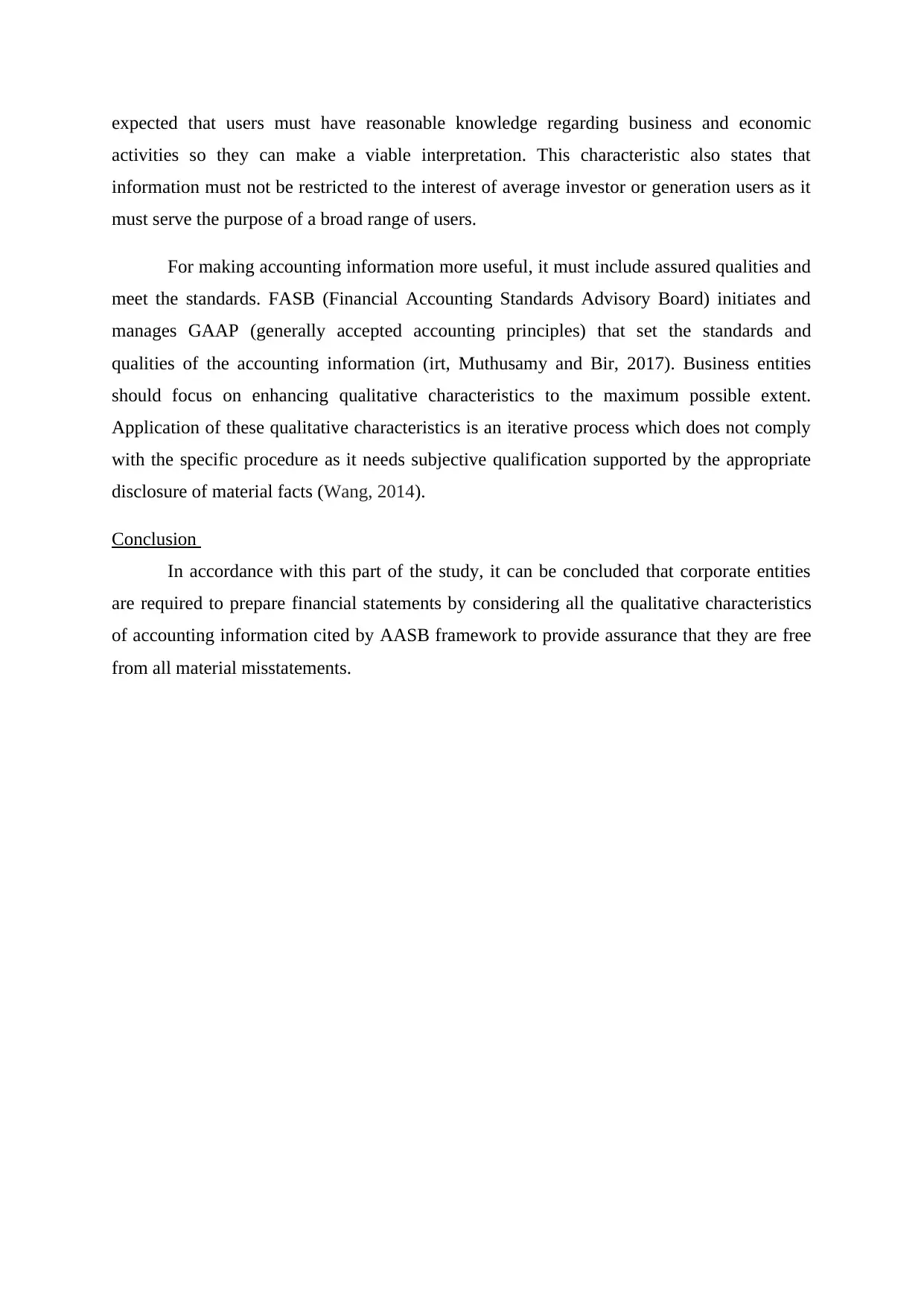
expected that users must have reasonable knowledge regarding business and economic
activities so they can make a viable interpretation. This characteristic also states that
information must not be restricted to the interest of average investor or generation users as it
must serve the purpose of a broad range of users.
For making accounting information more useful, it must include assured qualities and
meet the standards. FASB (Financial Accounting Standards Advisory Board) initiates and
manages GAAP (generally accepted accounting principles) that set the standards and
qualities of the accounting information (irt, Muthusamy and Bir, 2017). Business entities
should focus on enhancing qualitative characteristics to the maximum possible extent.
Application of these qualitative characteristics is an iterative process which does not comply
with the specific procedure as it needs subjective qualification supported by the appropriate
disclosure of material facts (Wang, 2014).
Conclusion
In accordance with this part of the study, it can be concluded that corporate entities
are required to prepare financial statements by considering all the qualitative characteristics
of accounting information cited by AASB framework to provide assurance that they are free
from all material misstatements.
activities so they can make a viable interpretation. This characteristic also states that
information must not be restricted to the interest of average investor or generation users as it
must serve the purpose of a broad range of users.
For making accounting information more useful, it must include assured qualities and
meet the standards. FASB (Financial Accounting Standards Advisory Board) initiates and
manages GAAP (generally accepted accounting principles) that set the standards and
qualities of the accounting information (irt, Muthusamy and Bir, 2017). Business entities
should focus on enhancing qualitative characteristics to the maximum possible extent.
Application of these qualitative characteristics is an iterative process which does not comply
with the specific procedure as it needs subjective qualification supported by the appropriate
disclosure of material facts (Wang, 2014).
Conclusion
In accordance with this part of the study, it can be concluded that corporate entities
are required to prepare financial statements by considering all the qualitative characteristics
of accounting information cited by AASB framework to provide assurance that they are free
from all material misstatements.
⊘ This is a preview!⊘
Do you want full access?
Subscribe today to unlock all pages.

Trusted by 1+ million students worldwide
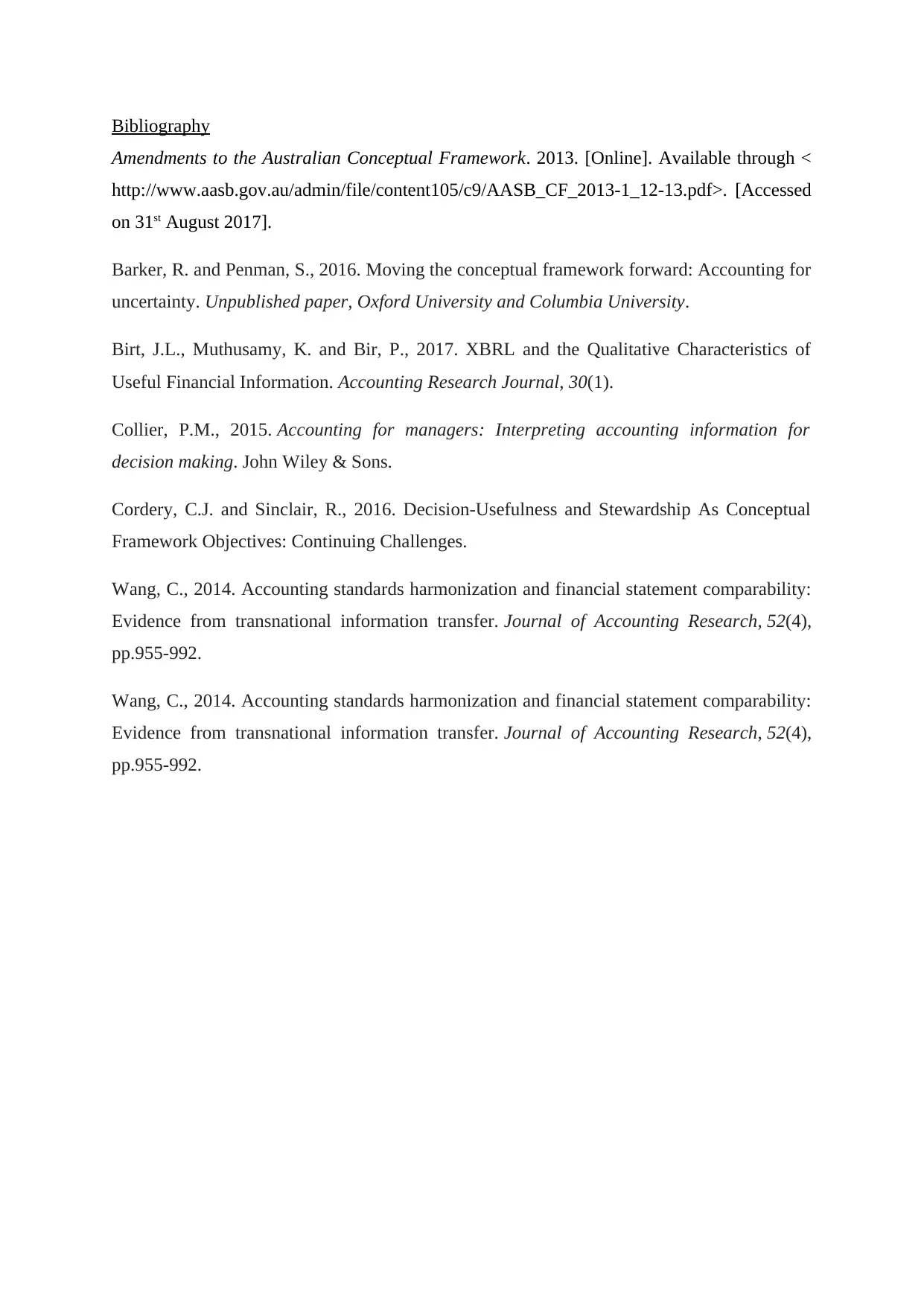
Bibliography
Amendments to the Australian Conceptual Framework. 2013. [Online]. Available through <
http://www.aasb.gov.au/admin/file/content105/c9/AASB_CF_2013-1_12-13.pdf>. [Accessed
on 31st August 2017].
Barker, R. and Penman, S., 2016. Moving the conceptual framework forward: Accounting for
uncertainty. Unpublished paper, Oxford University and Columbia University.
Birt, J.L., Muthusamy, K. and Bir, P., 2017. XBRL and the Qualitative Characteristics of
Useful Financial Information. Accounting Research Journal, 30(1).
Collier, P.M., 2015. Accounting for managers: Interpreting accounting information for
decision making. John Wiley & Sons.
Cordery, C.J. and Sinclair, R., 2016. Decision-Usefulness and Stewardship As Conceptual
Framework Objectives: Continuing Challenges.
Wang, C., 2014. Accounting standards harmonization and financial statement comparability:
Evidence from transnational information transfer. Journal of Accounting Research, 52(4),
pp.955-992.
Wang, C., 2014. Accounting standards harmonization and financial statement comparability:
Evidence from transnational information transfer. Journal of Accounting Research, 52(4),
pp.955-992.
Amendments to the Australian Conceptual Framework. 2013. [Online]. Available through <
http://www.aasb.gov.au/admin/file/content105/c9/AASB_CF_2013-1_12-13.pdf>. [Accessed
on 31st August 2017].
Barker, R. and Penman, S., 2016. Moving the conceptual framework forward: Accounting for
uncertainty. Unpublished paper, Oxford University and Columbia University.
Birt, J.L., Muthusamy, K. and Bir, P., 2017. XBRL and the Qualitative Characteristics of
Useful Financial Information. Accounting Research Journal, 30(1).
Collier, P.M., 2015. Accounting for managers: Interpreting accounting information for
decision making. John Wiley & Sons.
Cordery, C.J. and Sinclair, R., 2016. Decision-Usefulness and Stewardship As Conceptual
Framework Objectives: Continuing Challenges.
Wang, C., 2014. Accounting standards harmonization and financial statement comparability:
Evidence from transnational information transfer. Journal of Accounting Research, 52(4),
pp.955-992.
Wang, C., 2014. Accounting standards harmonization and financial statement comparability:
Evidence from transnational information transfer. Journal of Accounting Research, 52(4),
pp.955-992.
Paraphrase This Document
Need a fresh take? Get an instant paraphrase of this document with our AI Paraphraser
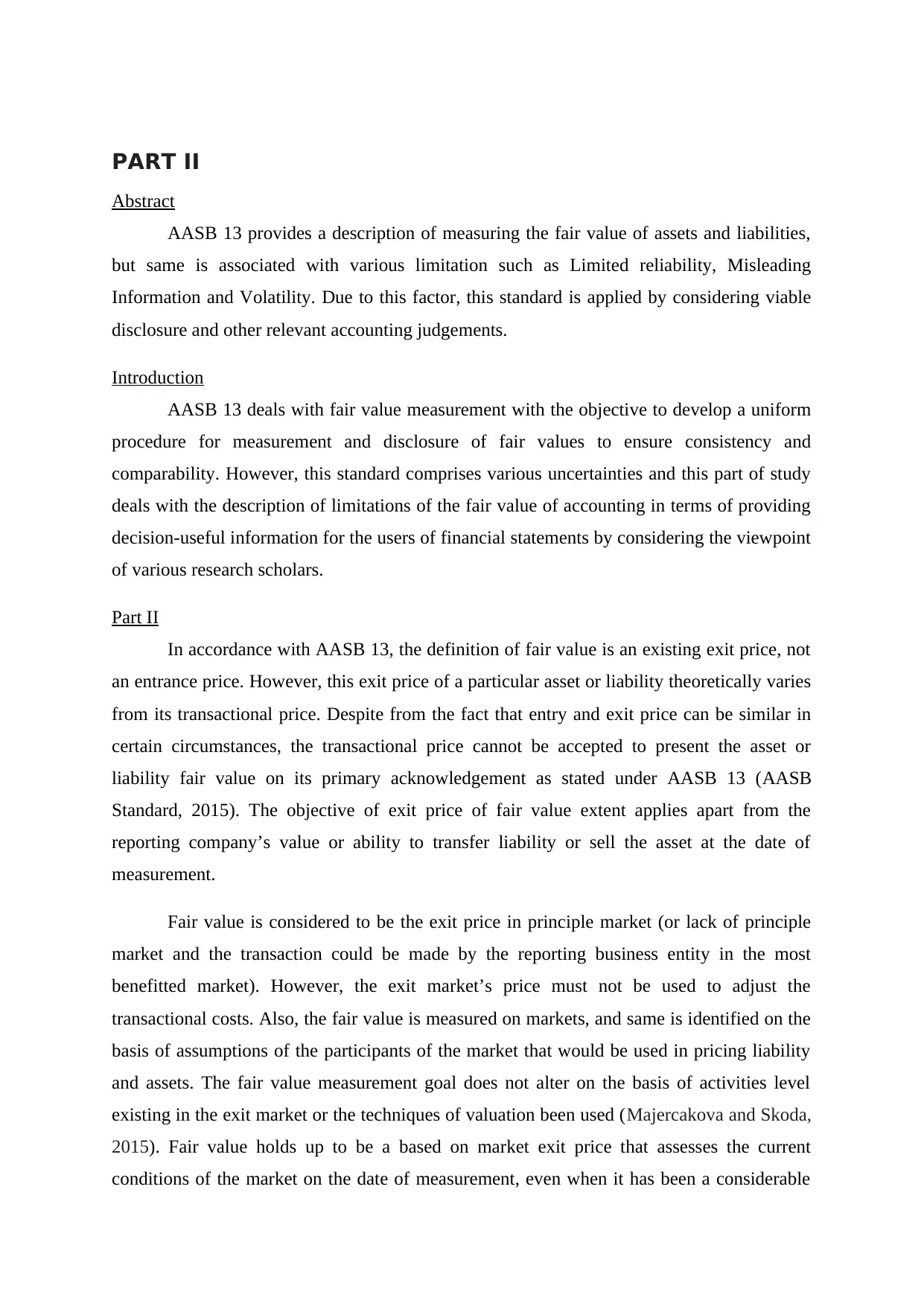
PART II
Abstract
AASB 13 provides a description of measuring the fair value of assets and liabilities,
but same is associated with various limitation such as Limited reliability, Misleading
Information and Volatility. Due to this factor, this standard is applied by considering viable
disclosure and other relevant accounting judgements.
Introduction
AASB 13 deals with fair value measurement with the objective to develop a uniform
procedure for measurement and disclosure of fair values to ensure consistency and
comparability. However, this standard comprises various uncertainties and this part of study
deals with the description of limitations of the fair value of accounting in terms of providing
decision-useful information for the users of financial statements by considering the viewpoint
of various research scholars.
Part II
In accordance with AASB 13, the definition of fair value is an existing exit price, not
an entrance price. However, this exit price of a particular asset or liability theoretically varies
from its transactional price. Despite from the fact that entry and exit price can be similar in
certain circumstances, the transactional price cannot be accepted to present the asset or
liability fair value on its primary acknowledgement as stated under AASB 13 (AASB
Standard, 2015). The objective of exit price of fair value extent applies apart from the
reporting company’s value or ability to transfer liability or sell the asset at the date of
measurement.
Fair value is considered to be the exit price in principle market (or lack of principle
market and the transaction could be made by the reporting business entity in the most
benefitted market). However, the exit market’s price must not be used to adjust the
transactional costs. Also, the fair value is measured on markets, and same is identified on the
basis of assumptions of the participants of the market that would be used in pricing liability
and assets. The fair value measurement goal does not alter on the basis of activities level
existing in the exit market or the techniques of valuation been used (Majercakova and Skoda,
2015). Fair value holds up to be a based on market exit price that assesses the current
conditions of the market on the date of measurement, even when it has been a considerable
Abstract
AASB 13 provides a description of measuring the fair value of assets and liabilities,
but same is associated with various limitation such as Limited reliability, Misleading
Information and Volatility. Due to this factor, this standard is applied by considering viable
disclosure and other relevant accounting judgements.
Introduction
AASB 13 deals with fair value measurement with the objective to develop a uniform
procedure for measurement and disclosure of fair values to ensure consistency and
comparability. However, this standard comprises various uncertainties and this part of study
deals with the description of limitations of the fair value of accounting in terms of providing
decision-useful information for the users of financial statements by considering the viewpoint
of various research scholars.
Part II
In accordance with AASB 13, the definition of fair value is an existing exit price, not
an entrance price. However, this exit price of a particular asset or liability theoretically varies
from its transactional price. Despite from the fact that entry and exit price can be similar in
certain circumstances, the transactional price cannot be accepted to present the asset or
liability fair value on its primary acknowledgement as stated under AASB 13 (AASB
Standard, 2015). The objective of exit price of fair value extent applies apart from the
reporting company’s value or ability to transfer liability or sell the asset at the date of
measurement.
Fair value is considered to be the exit price in principle market (or lack of principle
market and the transaction could be made by the reporting business entity in the most
benefitted market). However, the exit market’s price must not be used to adjust the
transactional costs. Also, the fair value is measured on markets, and same is identified on the
basis of assumptions of the participants of the market that would be used in pricing liability
and assets. The fair value measurement goal does not alter on the basis of activities level
existing in the exit market or the techniques of valuation been used (Majercakova and Skoda,
2015). Fair value holds up to be a based on market exit price that assesses the current
conditions of the market on the date of measurement, even when it has been a considerable

reduction in the level of activities for the liability and assets. AASB 13 standard states fair
value as the price been received in order to sell the asset or to pay off a liability in a timely
and systematic transaction among participant of the market at the date of measurement.
AASB 13 is the Standard which defines fair value and sets out a particular framework to
measure fair value and needs company’s disclosures regarding the measurement of fair value.
Fair value is based on market measurement, not a company’s particular measurement.
Information cannot be provided for certain assets and liabilities on the basis of noticeable
transactions or information of market (Hu, Percy and Yao, 2015). However, fair value
measurement aim in both the cases is similar, that is to consider the value at which an orderly
transaction is to be done for the sale of asset or liability will occur between the participants of
the market at the date of measurement under the existing market conditions. That is at the
date of, measurement the exit price from the view of market participant which is holding the
asset or outstanding liability
The standard is applied if another standard need or enables the disclosures or fair
value regarding the measurements such as fair value deduced by costs to make it in sellable
conditions, based on fair value or disclosures about those measurements), except which are
specifies in the following paragraphs such as Transactions of share based payments within
the extent of AASB 2 (Freeman, Wells and Wyatt, 2017). Transactions of leasing within the
extent of AASB 117. Measurements which consists same fair value, however, but aren’t fair
value. For example, under AASB 102 Inventories of net realisable value or value in use in
AASB 136 Impairment of Assets. The standard requires disclosure but not required for these
specific transactions, which are covered under AASB 119 Employee Benefits) plan assets
measured at fair value and AASB 136 assets for which recoverable amount is a fair value
fewer costs of disposal.
By considering above described literature primary limitations associated with this standard is
enumerated as below:
Limited reliability
It is negotiated that the method of fair value accounting which provides the
information is reliable and relevant for a certain period of time. As the financial statement
information is time-particular for the specified market condition. From the point of an
inexperienced expert in accounting, they will suffer from confusion by seeing changes in the
value as the price been received in order to sell the asset or to pay off a liability in a timely
and systematic transaction among participant of the market at the date of measurement.
AASB 13 is the Standard which defines fair value and sets out a particular framework to
measure fair value and needs company’s disclosures regarding the measurement of fair value.
Fair value is based on market measurement, not a company’s particular measurement.
Information cannot be provided for certain assets and liabilities on the basis of noticeable
transactions or information of market (Hu, Percy and Yao, 2015). However, fair value
measurement aim in both the cases is similar, that is to consider the value at which an orderly
transaction is to be done for the sale of asset or liability will occur between the participants of
the market at the date of measurement under the existing market conditions. That is at the
date of, measurement the exit price from the view of market participant which is holding the
asset or outstanding liability
The standard is applied if another standard need or enables the disclosures or fair
value regarding the measurements such as fair value deduced by costs to make it in sellable
conditions, based on fair value or disclosures about those measurements), except which are
specifies in the following paragraphs such as Transactions of share based payments within
the extent of AASB 2 (Freeman, Wells and Wyatt, 2017). Transactions of leasing within the
extent of AASB 117. Measurements which consists same fair value, however, but aren’t fair
value. For example, under AASB 102 Inventories of net realisable value or value in use in
AASB 136 Impairment of Assets. The standard requires disclosure but not required for these
specific transactions, which are covered under AASB 119 Employee Benefits) plan assets
measured at fair value and AASB 136 assets for which recoverable amount is a fair value
fewer costs of disposal.
By considering above described literature primary limitations associated with this standard is
enumerated as below:
Limited reliability
It is negotiated that the method of fair value accounting which provides the
information is reliable and relevant for a certain period of time. As the financial statement
information is time-particular for the specified market condition. From the point of an
inexperienced expert in accounting, they will suffer from confusion by seeing changes in the
⊘ This is a preview!⊘
Do you want full access?
Subscribe today to unlock all pages.

Trusted by 1+ million students worldwide
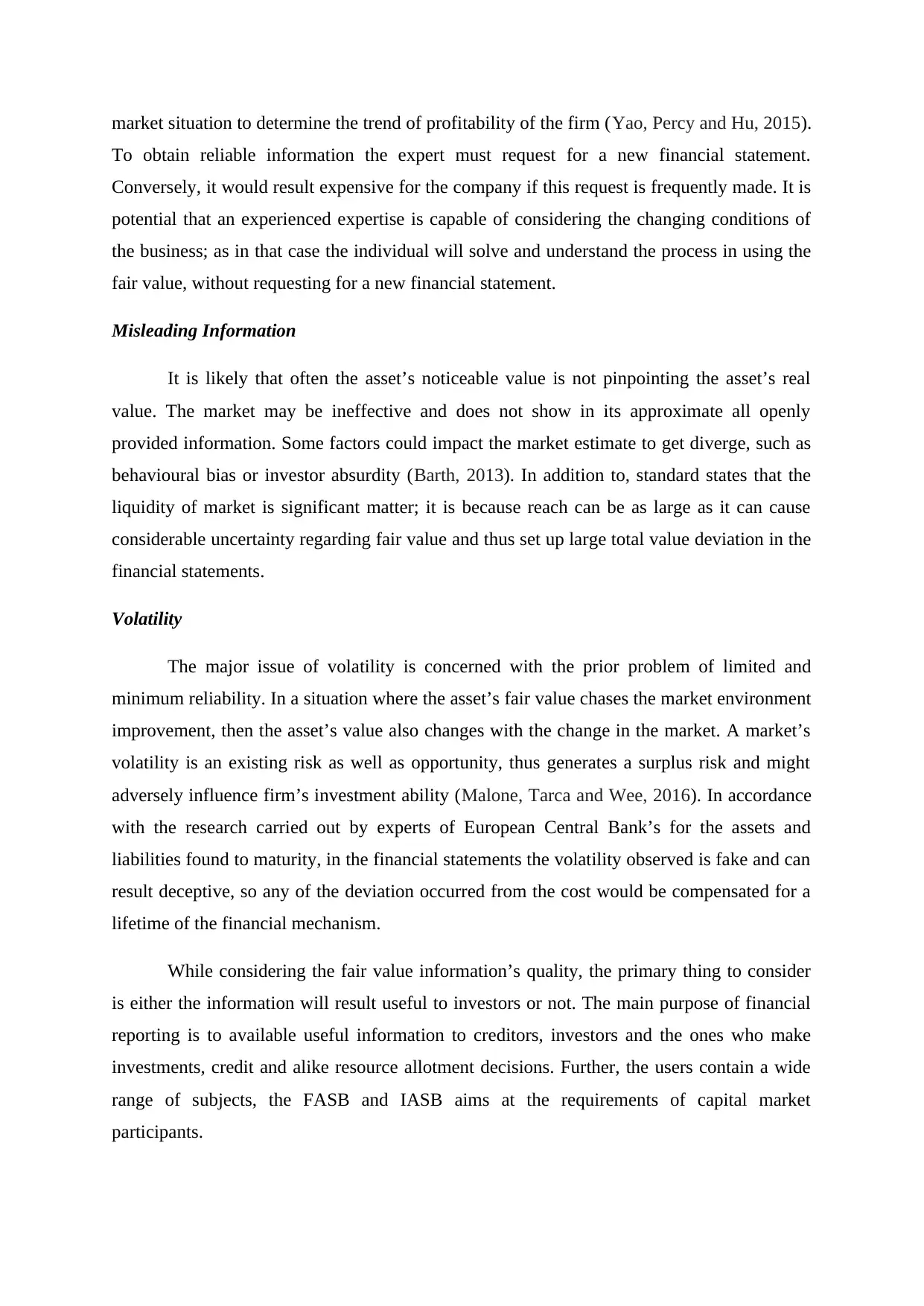
market situation to determine the trend of profitability of the firm (Yao, Percy and Hu, 2015).
To obtain reliable information the expert must request for a new financial statement.
Conversely, it would result expensive for the company if this request is frequently made. It is
potential that an experienced expertise is capable of considering the changing conditions of
the business; as in that case the individual will solve and understand the process in using the
fair value, without requesting for a new financial statement.
Misleading Information
It is likely that often the asset’s noticeable value is not pinpointing the asset’s real
value. The market may be ineffective and does not show in its approximate all openly
provided information. Some factors could impact the market estimate to get diverge, such as
behavioural bias or investor absurdity (Barth, 2013). In addition to, standard states that the
liquidity of market is significant matter; it is because reach can be as large as it can cause
considerable uncertainty regarding fair value and thus set up large total value deviation in the
financial statements.
Volatility
The major issue of volatility is concerned with the prior problem of limited and
minimum reliability. In a situation where the asset’s fair value chases the market environment
improvement, then the asset’s value also changes with the change in the market. A market’s
volatility is an existing risk as well as opportunity, thus generates a surplus risk and might
adversely influence firm’s investment ability (Malone, Tarca and Wee, 2016). In accordance
with the research carried out by experts of European Central Bank’s for the assets and
liabilities found to maturity, in the financial statements the volatility observed is fake and can
result deceptive, so any of the deviation occurred from the cost would be compensated for a
lifetime of the financial mechanism.
While considering the fair value information’s quality, the primary thing to consider
is either the information will result useful to investors or not. The main purpose of financial
reporting is to available useful information to creditors, investors and the ones who make
investments, credit and alike resource allotment decisions. Further, the users contain a wide
range of subjects, the FASB and IASB aims at the requirements of capital market
participants.
To obtain reliable information the expert must request for a new financial statement.
Conversely, it would result expensive for the company if this request is frequently made. It is
potential that an experienced expertise is capable of considering the changing conditions of
the business; as in that case the individual will solve and understand the process in using the
fair value, without requesting for a new financial statement.
Misleading Information
It is likely that often the asset’s noticeable value is not pinpointing the asset’s real
value. The market may be ineffective and does not show in its approximate all openly
provided information. Some factors could impact the market estimate to get diverge, such as
behavioural bias or investor absurdity (Barth, 2013). In addition to, standard states that the
liquidity of market is significant matter; it is because reach can be as large as it can cause
considerable uncertainty regarding fair value and thus set up large total value deviation in the
financial statements.
Volatility
The major issue of volatility is concerned with the prior problem of limited and
minimum reliability. In a situation where the asset’s fair value chases the market environment
improvement, then the asset’s value also changes with the change in the market. A market’s
volatility is an existing risk as well as opportunity, thus generates a surplus risk and might
adversely influence firm’s investment ability (Malone, Tarca and Wee, 2016). In accordance
with the research carried out by experts of European Central Bank’s for the assets and
liabilities found to maturity, in the financial statements the volatility observed is fake and can
result deceptive, so any of the deviation occurred from the cost would be compensated for a
lifetime of the financial mechanism.
While considering the fair value information’s quality, the primary thing to consider
is either the information will result useful to investors or not. The main purpose of financial
reporting is to available useful information to creditors, investors and the ones who make
investments, credit and alike resource allotment decisions. Further, the users contain a wide
range of subjects, the FASB and IASB aims at the requirements of capital market
participants.
Paraphrase This Document
Need a fresh take? Get an instant paraphrase of this document with our AI Paraphraser
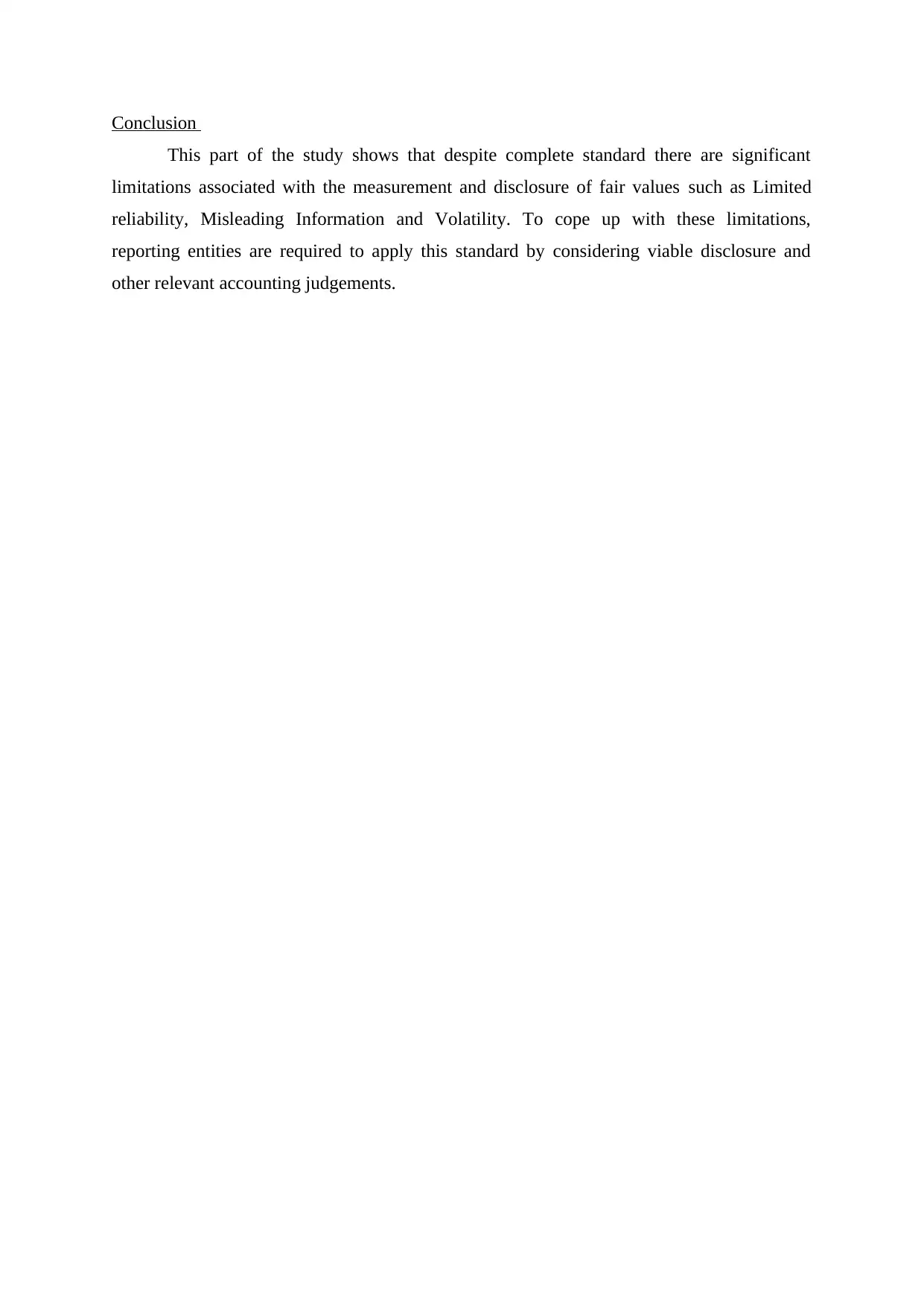
Conclusion
This part of the study shows that despite complete standard there are significant
limitations associated with the measurement and disclosure of fair values such as Limited
reliability, Misleading Information and Volatility. To cope up with these limitations,
reporting entities are required to apply this standard by considering viable disclosure and
other relevant accounting judgements.
This part of the study shows that despite complete standard there are significant
limitations associated with the measurement and disclosure of fair values such as Limited
reliability, Misleading Information and Volatility. To cope up with these limitations,
reporting entities are required to apply this standard by considering viable disclosure and
other relevant accounting judgements.
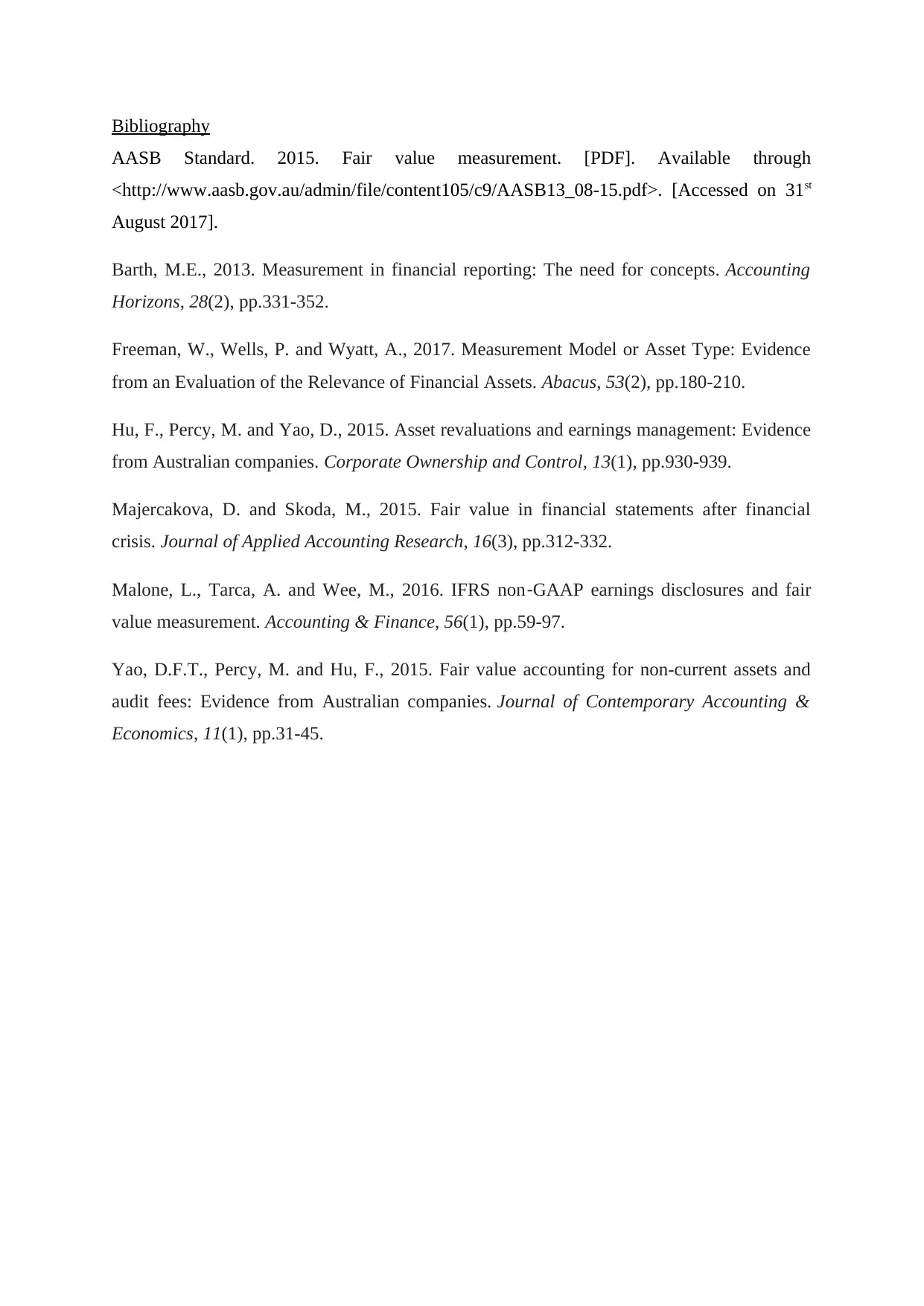
Bibliography
AASB Standard. 2015. Fair value measurement. [PDF]. Available through
<http://www.aasb.gov.au/admin/file/content105/c9/AASB13_08-15.pdf>. [Accessed on 31st
August 2017].
Barth, M.E., 2013. Measurement in financial reporting: The need for concepts. Accounting
Horizons, 28(2), pp.331-352.
Freeman, W., Wells, P. and Wyatt, A., 2017. Measurement Model or Asset Type: Evidence
from an Evaluation of the Relevance of Financial Assets. Abacus, 53(2), pp.180-210.
Hu, F., Percy, M. and Yao, D., 2015. Asset revaluations and earnings management: Evidence
from Australian companies. Corporate Ownership and Control, 13(1), pp.930-939.
Majercakova, D. and Skoda, M., 2015. Fair value in financial statements after financial
crisis. Journal of Applied Accounting Research, 16(3), pp.312-332.
Malone, L., Tarca, A. and Wee, M., 2016. IFRS non‐GAAP earnings disclosures and fair
value measurement. Accounting & Finance, 56(1), pp.59-97.
Yao, D.F.T., Percy, M. and Hu, F., 2015. Fair value accounting for non-current assets and
audit fees: Evidence from Australian companies. Journal of Contemporary Accounting &
Economics, 11(1), pp.31-45.
AASB Standard. 2015. Fair value measurement. [PDF]. Available through
<http://www.aasb.gov.au/admin/file/content105/c9/AASB13_08-15.pdf>. [Accessed on 31st
August 2017].
Barth, M.E., 2013. Measurement in financial reporting: The need for concepts. Accounting
Horizons, 28(2), pp.331-352.
Freeman, W., Wells, P. and Wyatt, A., 2017. Measurement Model or Asset Type: Evidence
from an Evaluation of the Relevance of Financial Assets. Abacus, 53(2), pp.180-210.
Hu, F., Percy, M. and Yao, D., 2015. Asset revaluations and earnings management: Evidence
from Australian companies. Corporate Ownership and Control, 13(1), pp.930-939.
Majercakova, D. and Skoda, M., 2015. Fair value in financial statements after financial
crisis. Journal of Applied Accounting Research, 16(3), pp.312-332.
Malone, L., Tarca, A. and Wee, M., 2016. IFRS non‐GAAP earnings disclosures and fair
value measurement. Accounting & Finance, 56(1), pp.59-97.
Yao, D.F.T., Percy, M. and Hu, F., 2015. Fair value accounting for non-current assets and
audit fees: Evidence from Australian companies. Journal of Contemporary Accounting &
Economics, 11(1), pp.31-45.
⊘ This is a preview!⊘
Do you want full access?
Subscribe today to unlock all pages.

Trusted by 1+ million students worldwide
1 out of 17
Related Documents
Your All-in-One AI-Powered Toolkit for Academic Success.
+13062052269
info@desklib.com
Available 24*7 on WhatsApp / Email
![[object Object]](/_next/static/media/star-bottom.7253800d.svg)
Unlock your academic potential
Copyright © 2020–2025 A2Z Services. All Rights Reserved. Developed and managed by ZUCOL.





